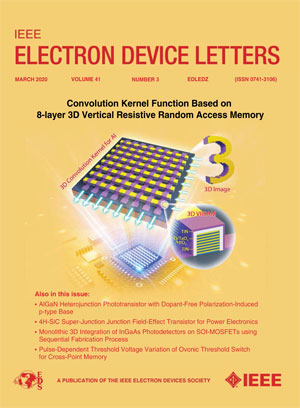具有全漂移电子积累效应的新型鳍形漂移SOI LDMOS
IF 4.1
2区 工程技术
Q2 ENGINEERING, ELECTRICAL & ELECTRONIC
引用次数: 0
摘要
本文提出了一种基于绝缘体上硅(SOI)结构的新型横向双扩散MOSFET,该结构具有漂移全能电子积累层(EAL) (DAA-LDMOS)。DAA结构包括一个自适应电位区(SAP)周围的鳍形漂移区,和一个控制电极SAP区域顶部。SAP区和埋藏氧化物(BOX)层的电位永远高于漂移区,保持不变的电位差,从而在漂移区引入了3D全封闭矩形EAL。此外,控制电极可以灵活地调节EAL的强度,以达到最佳的积累效果。因此,该器件具有极宽的电流通路和超低电阻,显著降低了比导通电阻R ${}_{\mathbf {\textit {ON},\textit {sp}}}$。仿真结果表明,DAA-LDMOS的${R} _{\mathbf {\textit {ON},\textit {sp}} $比传统LDMOS的${\Omega $ cm ${}^{\mathbf{{2}}}$减小。在相同击穿电压BV为260 V时,LDMOS无累加效应达到0.28 m $\Omega $ cm ${}^{\mathbf{{2}}}$,降低了97.7%。DAA-LDMOS的性能因数(FOM)由Cov的5.5 MW/cm ${}^{\mathbf{{2}}}$增加。LDMOS达到创纪录的237.7 MW/cm ${}^{\mathbf{{2}}}$,表现出优异的性能。本文章由计算机程序翻译,如有差异,请以英文原文为准。
Novel Fin-Shaped Drift SOI LDMOS Featuring Drift-All-Around Electron Accumulation Effect
This letter proposes a novel lateral double-diffused MOSFET based on a silicon-on-insulator (SOI) structure with a drift-all-around electron accumulation layer (EAL) (DAA-LDMOS). The DAA structure incorporates a self-adaptive potential region (SAP) surrounding a fin-shaped drift region, and a control electrode atop the SAP region. The potential existing in the SAP region and buried oxide (BOX) layer is perpetually higher than in the drift region, maintaining an unwavering potential differential, which introduces a 3D fully enclosed rectangular EAL in the drift region. Moreover, a control electrode can deftly modulate the intensity of the EAL to achieve the optimal accumulation effect. Consequently, the device possesses an extremely wide current path with ultralow resistance, dramatically decreasing the specific ON-resistance R ${}_{\mathbf {\textit {ON},\textit {sp}}}$ . The simulation results show that the ${R} _{\mathbf {\textit {ON},\textit {sp}}}$ of the DAA-LDMOS was reduced from 12.56m $\Omega $ cm ${}^{\mathbf {{2}}}$ of the conventional LDMOS (Cov. LDMOS) without accumulation effect to 0.28 m $\Omega $ cm ${}^{\mathbf {{2}}}$ , a reduction of 97.7% at the same breakdown voltage BV of 260 V. The figure-of-merit (FOM) of the DAA-LDMOS increased from 5.5 MW/cm ${}^{\mathbf {{2}}}$ of the Cov. LDMOS to a record high of 237.7 MW/cm ${}^{\mathbf {{2}}}$ , demonstrating an exceptional performance.
求助全文
通过发布文献求助,成功后即可免费获取论文全文。
去求助
来源期刊

IEEE Electron Device Letters
工程技术-工程:电子与电气
CiteScore
8.20
自引率
10.20%
发文量
551
审稿时长
1.4 months
期刊介绍:
IEEE Electron Device Letters publishes original and significant contributions relating to the theory, modeling, design, performance and reliability of electron and ion integrated circuit devices and interconnects, involving insulators, metals, organic materials, micro-plasmas, semiconductors, quantum-effect structures, vacuum devices, and emerging materials with applications in bioelectronics, biomedical electronics, computation, communications, displays, microelectromechanics, imaging, micro-actuators, nanoelectronics, optoelectronics, photovoltaics, power ICs and micro-sensors.
 求助内容:
求助内容: 应助结果提醒方式:
应助结果提醒方式:


